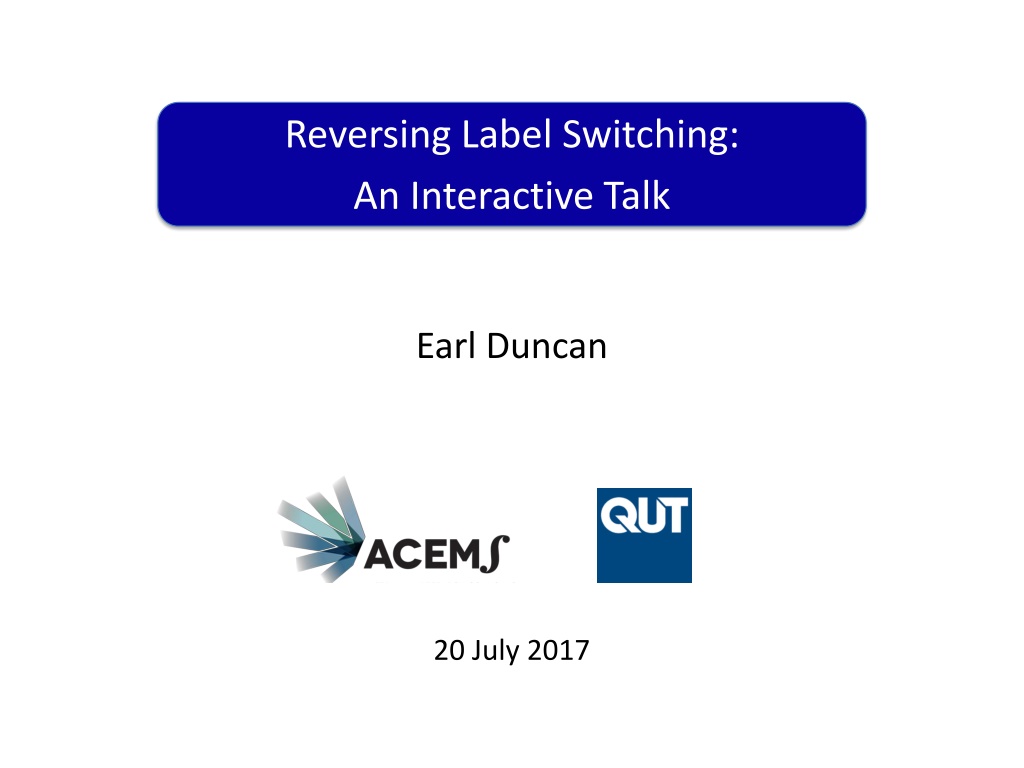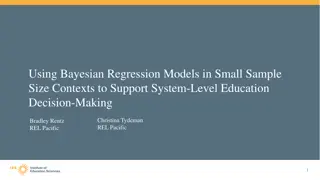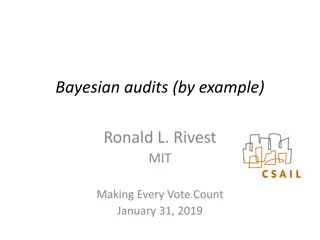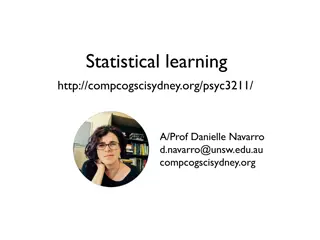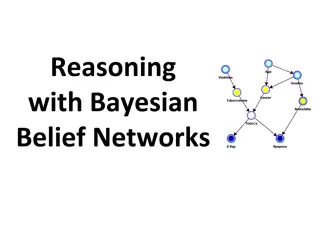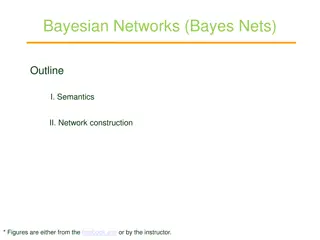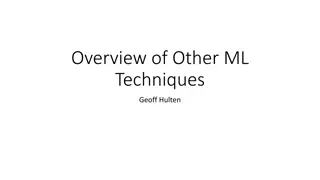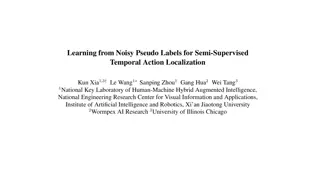Understanding Label Switching in Bayesian Mixture Models
In the interactive talk "Reversing Label Switching" by Earl Duncan, the concept of label switching in Bayesian mixture models is explored. Label switching poses challenges in making accurate inferences due to symmetric modes in posterior distributions. Duncan discusses conditions for observing label switching and emphasizes the importance of relabelling algorithms to reverse label switching for meaningful inferences.
Download Presentation

Please find below an Image/Link to download the presentation.
The content on the website is provided AS IS for your information and personal use only. It may not be sold, licensed, or shared on other websites without obtaining consent from the author. Download presentation by click this link. If you encounter any issues during the download, it is possible that the publisher has removed the file from their server.
E N D
Presentation Transcript
Reversing Label Switching: An Interactive Talk Earl Duncan 20 July 2017
Introduction Given observed data ? = ?1, ,??, the ?-component mixture model is expressed as ? ? ? ~ ? ? ?,? = ???????? ?=1 ?=1 where ?? denotes unknown component-specific parameter(s), and ??( ) is the ?th component density with corresponding mixture weight ?? subject to: ? ?=1 ??= 1 and ?? 0 for ? = 1, ,?. Marin, J-M., K. Mengersen, and C. P. Robert. 2005. Bayesian modelling and inference on mixtures of distributions In Handbook of Statistics edited C. Rao and D. Dey. New York: Springer-Verlag. Earl Duncan BRAG 20 July 2017: Reversing Label Switching 1/12
Introduction A latent allocation variable ?? is used to identify which component ?? belongs to. ????,? ~ ???????? ?? ? ~ Cat ?1, ,?? The likelihood is exchangeable meaning that it is invariant to permutations of the labels identifying the mixture components ? ? ? = ? ? ? ? E.g. ? ? ?1,?2 = ? ? ?2,?1 . for some permutation ?. If the posterior distribution is invariant to permutations of the labels, this is known as label switching (LS). Earl Duncan BRAG 20 July 2017: Reversing Label Switching 2/12
Introduction Consider the conditions: 1) the prior is (at least partly) exchangeable 2) the sampler is efficient at exploring the posterior hypersurface If condition 1 holds, the posterior will have (up to) ?! symmetric modes. If condition 1 and 2 hold, LS will occur (i.e. the symmetric modes will be observed). No label switching LS between groups 1 and 2 LS between all 3 groups Earl Duncan BRAG 20 July 2017: Reversing Label Switching 3/12
Introduction If label switching occurs, the marginal posterior distributions are identical for each component. Therefore, it is impossible to make inferences! K = 3 K = 4 Earl Duncan BRAG 20 July 2017: Reversing Label Switching 4/12
Introduction To make sensible inferences, one must first reverse the label switching using a relabelling algorithm. If/when LS occurs, determine the permutations ?(1), ,?(?) to undo the label switching. 2) Apply the permutations to ?, ?, and inverse permutations to ?. The function ?( ) can be regarded as a generic permutation function which either permutes or relabels. Let ? = (?1, ,??) be a permutation of the index set 1, ,? , let ? = (?1, ,??) be an arbitrary ?-length vector, and let ? = (?1,?2,?3, ) be an arbitrary length vector (or possibly scalar) containing only the values 1, ,? . Then: 1) ? ?1, ,?? = ??1, ,??? ? ?1,?2,?3, = ??1,??2,??3, Permute: Relabel: Earl Duncan BRAG 20 July 2017: Reversing Label Switching 5/12
Example Example: determining ? ?(?) can be determined from the posterior estimates ?(?) and a reference allocation vector ? = ?1, ,?? (? ). Earl Duncan BRAG 20 July 2017: Reversing Label Switching 6/12
Exercises Consider the following cross-tabulation of reference allocation vector ? = ?(? ) and ?(7) (here ? = 200). ? 1 2 90 0 0 2 3 0 2 1 35 4 0 14 3 1 0 0 52 0 1 2 3 4 ?(7) Question 1: What should the permutation ?(7) be to reverse the labels of a component-specific parameter, ?(7)? Hint: (3,1,4,2) or (2,4,1,3) Answer: ?(7)= (3,1,4,2) Earl Duncan BRAG 20 July 2017: Reversing Label Switching 7/12
Exercises The second step requires this permutation to be applied to the component-specific parameters and the labels. Question 2: If ?(7)= (0.5,0.1,0.3,0.2) and ?(7)= (3,4,2,2,3, ), what are the resulting estimates after relabelling? Recall ?(7)= (3,1,4,2). Hint: Permuting: ? ?1, ,?? = ??1, ,??? Relabelling: ? ?1,?2,?3, = ??1,??2,??3, Answer: ?(7):= ?70.5,0.1,0.3,0.2 = 0.3,0.5,0.2,0.1 ? (3,4,2,2,3, ) ?(7):= ?7 1, ??2 1, ?4 1, ??3 1, ?2 1, ??4 1,?2 1,??5 1,?3 1, ) =(??1 =(?3 =(1,3,4,4,1, ) 1, ) Earl Duncan BRAG 20 July 2017: Reversing Label Switching 8/12
Exercises Question 3: Why is the inverse permutation used to relabel ?? Hint: Consider drawing values from 3 component densities. Introduce LS, and note how the new values of ? and ? are recorded. ? ? ? ? ? ? ? w/o LS w/ LS Answer: Draw values without LS, then with LS: ? 10 20 0 10 20 0 1= (3,1,2) ?LS= (2,3,1) ? = ?LS But how are the values of ? recorded? Earl Duncan BRAG 20 July 2017: Reversing Label Switching 9/12
Exercises Answer continued: ?LS= (2,3,1) ? = (3,1,2) ? 1= ?LS= (2,3,1) ? 10 20 0 10 20 0 2 1 3 2 1 3 Draw from Middle, but label it 1 Draw from Right, but label it 2 Draw from Left, but label it 3 ? ? ? 1(?2) = (??1 1,??2 1,?2 1,??3 1,?3 1,??4 1,?1 1,??5 1,?3 1, ) 3 ? 3 2 3 ? 3 2 1 ? 1 3 2 ? 2 1 1 3 1 ? 1, ) = (?2 = (3,3,1,2,1, ) Earl Duncan BRAG 20 July 2017: Reversing Label Switching 10/12
Comparison of Relabelling Algorithms Earl Duncan BRAG 20 July 2017: Reversing Label Switching 11/12
Questions? Any questions? Earl Duncan BRAG 20 July 2017: Reversing Label Switching 12/12
